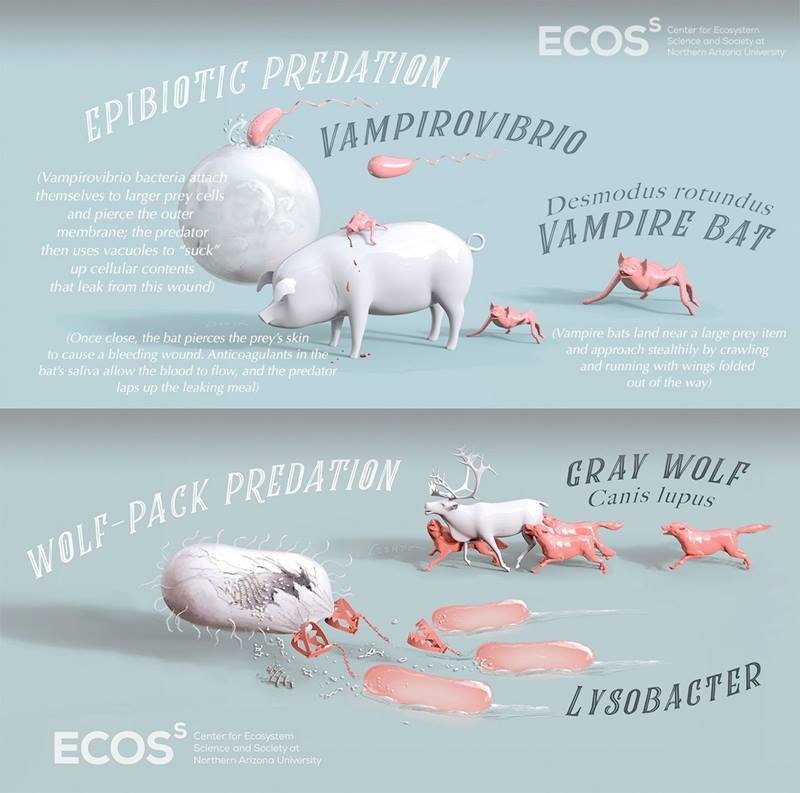04/27/2021
Predatory Bacteria, Eat Thy Neighbor
In natural soil, predatory bacteria grow faster than their prey.

Predatory bacteria use wolfpack-like behavior, enzymes, and structures to hunt and feast on other bacteria.
[Image by Victor Leshyk, Center for Ecosystem Science and Society, Northern Arizona University ]
The Science
Like every other life form on earth, bacteria belong to food webs. These webs connect organisms with one another based on what and how they eat. In food webs of animals, ecologists have long understood that adding more food like grass and shrubs that prey animals eat can also benefit predators such as wolves. Scientists wanted to understand whether the same principles apply in bacterial food webs. By comparing the results from many studies that used a technique called quantitative stable isotope probing, or qSIP, scientists found that predatory bacteria (bacteria that eat other bacteria) grow faster and consume more resources than non-predators in soil. These predators use wolfpack-like behavior, enzymes, and special structures (with roles similar to fangs) to hunt and feast on other bacteria. These predators wield important power in determining how soil nutrients move through the environment.
The Impact
Soil ecosystems contain more carbon than is stored in all the plants on Earth. Understanding how carbon and other elements move among soil organisms therefore helps us predict future climate change. Bacteria are very abundant in soil, and they have an enormous role in influencing whether nutrients are stored or lost in soils. Predatory bacteria’s outsized role in soil nutrient cycling is an important clue in understanding the microbiology of soil communities and soil health.
Summary
Scientists have a detailed understanding of the importance of predators, such as wolves and lions, in natural ecosystems. However, scientists know much less about bacterial predators, as their effect on the environment has been difficult to measure. To better understand bacterial predation and nutrient consumption, a team of scientists assembled dozens of smaller data snapshots from qSIP analysis: 82 sets of data from 15 sites in a range of ecosystems. The team used information about how bacteria behave in culture to categorize bacteria as obligate or facultative predators. Obligate predators solely feed on other bacteria, while facultative predators only sometimes do so. The researchers identified about 7 percent of all bacteria in the meta-analysis as predators, and the majority of those were facultative predators. Obligate predatory bacteria, like Bdellovibrionales and Vampirovibrionales, grew 36 percent faster and took up carbon more than three times as fast as non-predatory bacteria. When the soil received a boost of carbon, predatory bacteria used it to grow faster than other types. These differences were seen across all ecosystems and in the omnivorous bacteria, as well. These finding support the notions that higher productivity increases top-down predator control of lower trophic levels and that the importance of bacterial predators increases with energy flow. In turn, this affects the turnover of elements through microbial food webs.
Principal Investigator
Bruce Hungate
University of Northern Arizona
Bruce.Hungate@nau.edu
BER Program Manager
Boris Wawrik
U.S. Department of Energy, Biological and Environmental Research (SC-33)
Biological Systems Science Division
boris.wawrik@science.doe.gov
Funding
This work was supported by the Department of Energy Office of Science, Biological and Environmental Research Program.
References
Hungate, B.A., et al., The Functional Significance of Bacterial Predators. mBio, 12, 2 (2021). [DOI: 10.1128/mBio.00466-21]
